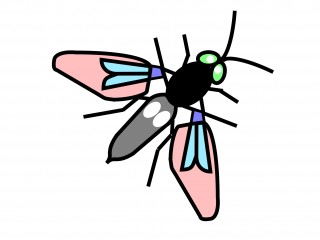Project Results:
Biological Urban Sanitation
Elimination of faecal sludge by flies
About the project
Project aimed to pilot the use of the (larvae of the) Black Soldier Fly to eliminate the faecal material in latrines by biological digestion. This would mean that pits can be less deep and do not need to be emptied (or changed). The project would include the research on the application of the fly, the design of the toilet/latrine and the practical piloting and the design of a business model.
Key results
-
Practical real life pilots with 10 households: 10 pilot latrines placed and researched.
-
Design of an affordable waterless toilet.
-
Start-up enterprise SusaMati for waterless toilet production.
-
15 people trained (esp. women groups), 5 employed.
-
Development of a business model.
Tips for the future
-
Biological processes are difficult to understand, e.g. instead of 3 months, it took 18 months to get sufficient flies and larvae. The reproduction cycle did not occur within the pit. The pit needs regular supply of outside grown larvae and/or the pit design needs adaptations.
-
Access to knowledge and means is crucial: intellectual property regulation should be well defined in the pre-agreement.
Potential for growth
The Pia toilet is a useful spin off that can support the business, being affordable for many households without a sewage connection and easy to produce. Though business plan and marketing plan are still very basic, SusaMati is an enterprise with potential, which can expand quickly. For 2019 Susamati is planning for 4,050 toilets; and 8,100 in 2020. Together these are 60,000 people. There is interest from World Bank and Action for the Hunger to integrated the toliet in their programmes.
Project partners
Annemarieke Mooijman Consulting in cooperation with LCS Promotion Int (Sweden), Municipality of Maputo, Centro de Investigação e Transferência de Tecnologias para o Desenvolvimento Comunitário (CITT)
Period
2016-March 2019
Location
Maputo, MozambiqueLast project updates
Background
The starting point of this project is to convert existing and/or new latrines from being traditional or sanplat pits for accumulation of faecal matter to small on-site sludge treatment stations where the faecal sludge is converted to CO2 and to seepage water which can be infiltrated (or used for control of pest flies). According to recent research Black Soldier Fly (BSF) Larvae can convert fresh human faecal matter in latrines to virtually no volume with reduced environmental risks and substantial long term savings. Using the right techniques this is also accessible and affordable to the lowest income groups, especially in urban areas.
In addition a low-cost, low water toilets, makes sure that pits are not getting too wet for black soldier flies to reproduce themselves.
Project Plan
The Project will cover a period of 32 months from May 2016 till December 2018:
1. The first year will focus on research and prototype development,
2. The second year will focus on piloting, assessment of socio-economic acceptance and training of entrepreneurs,
3. The third year will be used for scaling-up and marketing.
Given the innovative character of the project and that there are no earlier experiences of the biological sanitation system in Mozambique (or elsewhere) the implementation of the year 2 and 3 programme is subject to successful outcome of year one.
During the project period there will be documentation (through articles and a blog on the progress and findings) of the activities, successes, failures and findings in all phases of the project implementation.
Year 1 – Research and prototype development
Year one is a design and experimental year aiming at assessing the viability of the biological sanitation idea to build and maintain sustainable latrines:
a. Ongoing internet research (with support from academic researchers),
b. Design and testing of a small-scale BSF cage where a BSF colony is started by “inviting” pregnant BSFs by posing egg collectors at strategic places and let them hatch inside the cage,
c. Tentative design of technical options to understand function and the aspirations of the different client categories,
d. Experimental construction of 10 prototypes and conversion of 40 SanPlat latrines to biological sanitation with pia fantastica in Polana Canica, Maputo,
e. Training of 2-3 entrepreneurs,
f. Setting-up a monitoring and evaluation system, Experimental implementation,
g. Documentation (through written articles and a blog on the progress) of the activities, successes, failures and findings in all phases of the project implementation.
Year 2 – Piloting, assessment of socio-economic acceptance and training of entrepreneurs
The objective of the piloting phase is to assess possibilities and constraints for the expansion of the BioBed approach:
a. Pilot implementation to test the findings in a real setting (60 SanPlat conversions) in Polana Canica, Maputo while entrepreneurs market more biological sanitation and pia fantastica in areas of their own choice.
b. Discuss technical and socio-economic acceptance and potential strategies with humanitarian and development organizations, private sector, universities etc. in Maputo and beyond,
c. Promotion of the project with possibility for up to 20 social entrepreneurs to apply for participation; Selection of social entrepreneurs, training and testing, support (both technical and in marketing), support to setting-up businesses,
d. Participatory assessment of user and acceptance aspects with potential consumers/users,
e. Documentation (through written articles and a Facebook blog on the progress) of the activities, successes, failures and findings in all phases of the project implementation.
Year 3 - Scaling up and marketing
The third year is for assessing the possibilities of wide scale promotion and policy development:
a. Modifications and further development as required (in design and marketing),
b. Development of transformation kit concept (from SanPlat to biological sanitation with pia fantastica) for large scale application,
c. Scaling up the experiences from the pilot phase in order to understand possibilities and constraints of a rollout programme,
d. Documentation of the activities, successes, failures and findings in all phases of the project implementation,
e. Draft policy development (depending on the outcomes of the project).
Target group
The targeted experimental area in Maputo is Polana Canica. Within this area, special focus will be given that the test models are use by a representative population of the area, including women, single headed households, disabled, senior citizens, etc.
Further a group of 11 social entrepreneurs will be trained on the production and marketing of pia fantastica and BSF production
Sustainability
Given the assumed/suspected need for regular maintenance of the BSF cultures, provision of latrines should be made on contract basis where the entrepreneur assumes the full responsibility for construction and maintenance against a sustainable market adapted fee.
The project commits itself to assist to the selection training and monitoring (both technical and in marketing) of up to 20 entrepreneurs with businesses in the peri-urban areas. Beyond this the contractors would need to assume the full responsibility on their own.
In order to secure sustainable operation the implementation will, from the onset and onwards, be applying commercial principles where profitmaking, at all levels, is seen as a success criterion rather than a limiting conflict of interest.
Overview of Goals
To assess and develop the practical possibilities of marketing sustainable sanitation and mitigate constraints and risks through sludge reduction by Black Soldier Fly larvae consuming the fresh sludge inside the latrine, hence:
(1) Minimising the need for pit emptying etc, including physical contact and development of straight flush, low-cost, low-water use toilet Pia Fantastica,
(2) Create socio-economic acceptance towards the unconventional approach,
(3) Develop Pia Fantastica for commercial production and marketing, including the training of a group of 10 female and 1 mail producers with potential to become future produers and suppliers, In addition a group of ten people will be trained on community-based bsf production.
(4) Document all steps in the development process as learning and monitoring tool.
Results and indicators
- Research and Prototype development
- Entrepeneurs trained on Biological Sanitation 3 ( target )
- App. 20 entrepeneurs trained
- SanPlat conversion 40 ( target )
- upgrade and functioning of 100 Sanplats to BioBed,
- Prototypes developed 10 ( target )
- • App. 10 prototypes and test models functioning
- Functioning Monitoring and Documentation system ( target )
- The project aims for an efficient, cost-effective way to make sure that the monitoring is relevant, and not too much or too few data are being collected. Therefore at the start simple, operational, measurable indicators will be formulated. As much as possible the monitoring will be undertaken by partners and beneficiaries of the project as part of their daily/weekly/monthly routine, in order to notice changes or deviations from the expected.
The documentation consists of the publication of the findings from the monitoring activities through articles and a blog as well as every 6 months a project progress update and workplan. - BSF production secured
- Scaling-up and marketing
- Marketable BioBed designs and strategies developed to allow for scaling-up and sustainability
- Draft policy developped (depending on the outcomes of the project). ( target )
- A transformation kit (from SanPlat to BioBed) to be produced and sold by LCS Promotion ( target )
- piloting, assessment of socio-economic acceptance

